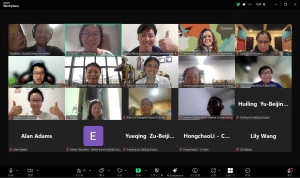
Bob Moseley is the director of the Asia-Pacific Cities Program at The Nature Conservancy (TNC). This interview was conducted by CDB’s Gabriel Corsetti on the 30th of November, on the sidelines of the World Philanthropy Forum in Beijing.
China Development Brief: Thanks for taking this interview. You worked in environmental protection in Yunnan for 6 years (from 2000 to late 2005). That was a very different time, so how would you say that environmental protection work in China has changed in the intervening years, and would you say that the environmental situation has improved all in all?
Bob Moseley: I think the recognition of the problem has definitely improved. Also most governments in the world are slow to change, but the discussions at the very highest level in China are fantastic. They are really setting up the stage for big improvements in the environment. I’m really optimistic there. I’m also really optimistic about the youth. You might have heard a little bit in the forum today about the millennial generation and what they want. What I see in the US is really very similar to here in China. That gives me great optimism.
When I lived in China, in Yunnan, I used to climb rocks in my spare time. I developed this strong relationship with some very young Chinese friends. It was just me as the one foreigner, and we would go out with all these Chinese people, and explore and rock-climb in the area. Then I came back and met the same people in Kunming last November, more than 10 years later. Of course they have grown up and have families now, but they still rock-climb. But what I noticed was that now they actually understand what I do better than they did then, even though I spent much more time with them then, and I tried to explain what I did, about the environment and conservation.
At the time they understood about setting up natural reserves at a very basic level, but now their outlook is much more sophisticated when it comes to their views of conservation. It is really positive, you really see a lot of opportunities in that. They are mostly in the Chinese private sector, and they are now in their 30s or 40s. When they were in their 20s, when I used to climb with them, they didn’t have any money. But now they are older, and they actually have the money, and they are gaining more influence in how the government plans for the type of things that their citizens are interested in.
CDB: On that note, could you tell us something about TNC’s future projects in China?
BM: Overall one of the themes is developing a role for the private sector, both in terms of civil society, NGOs, and also private enterprises, to contribute to conservation in China, and in the world, too. Because China now has a lot of private wealth that can fund things overseas.
I can give you an example of how we are getting people who support philanthropists here in China to help conservation in Africa, South America and other places in the world. Here in China that idea of bringing in the private sector, or civil society, is a theme that runs across a number of the areas and cities where we operate in land conservation and climate change.
An example in my work is the sponge city (海绵城市) program that was announced by the central government in 2015. The idea there is using nature and greenery to solve some really big issues around flooding that exist in Eastern Chinese cities. The social and economic impact of flooding in cities are getting it harder and harder for China to build its way out of, by building bigger pipes, bigger drainage systems or bigger pump systems. It’s just getting too much, and they recognize this. At the national level, they created this program called the Sponge City, literally meaning using nature as a sponge to absorb the water, instead of having it run off the streets into subways and people’s houses. But interestingly they didn’t give all the money to the cities to implement this, as the central government usually does. Instead they left some space for the cities to experiment on how to finance this program at a high level, at a scale that can really matter to a city. And a lot of that involves public-private partnerships (PPP). These PPP type projects are something we are really good at globally, and we are bringing some best ideas to China around that, including at a workshop in Shenzhen next week, for instance, on how to build PPP for innovative finance models. That’s an example of the idea of involving private money, that’s a theme that runs through a lot of our projects.
CDB: The sponge idea would be very useful in Beijing, because Beijing is a city that tends to get badly flooded. It doesn’t rain very often, so when it does it is not equipped.
BM: Yes, and it’s all paved. The water runs off very quickly. And there’s pollution with that. There are social and economic consequences, but also ecological consequences. An area that we are really interested in is that nexus between the socioeconomic and ecological consequences of environmental problems, and how you solve those and bring it all together.
CDB: I see. I was also very interested in the point about Chinese investing abroad that you made. We are in fact focusing a lot now on Chinese NGOs “going out”, as they say here, or Chinese getting involved in philanthropy other countries.
BM: In our operating unit here in China, and actually in many other countries, we have a local advisory board, a board of directors you might say, but just for our local programs. We have a number of rich entrepreneurs, there are 40 of them on our big board, and then another 30 on our junior board, who are basically all billionaires.
They were inspired by our global conservation work beyond the Chinese border and had an idea that they actually can contribute to conservation elsewhere in the world through the TNC. So what we did was we set up the China Global Conservation Fund(CGCF), here in our China office, with contributions to that fund from our Chinese board members.
It is a competitive grant process where internally we get proposals from different parts of our organization from all over the world. I’m actually on a working group that sieves some of the first cut, and elects the most qualified proposals to that committee of our board to review themselves, and they pick what those projects are.
This happens every year. In the past five years (2011-2016), the CGCF has granted more than 17 million dollars to support 21 TNC projects within the conservancy around the world. From forests to oceans, from wildlife conservation to sustainable community development, the Fund has greatly advanced TNC’s global conservation agenda.
The board meeting took place last Friday and decided on this year’s grantees. On this particular year, 1.8 million was given to five projects around the world, including in Brazil and Tanzania. The same thing will happen next year, so there’s another tranche of money coming in for another five years.
CDB: So the funding comes from China but the management of the projects is not Chinese?
BM: The fund is managed here in China, but the actual projects are managed by the local offices. So just like in China where we have almost 70 staff in 7 offices, we have a program in Tanzania, we have a big program in Brazil, and many other countries. So those local offices, they are the ones that actually write the proposals, and it is very competitive. We got 22 proposals this year and had to narrow it down to 10, and we gave them to the board, and the board only chose five of them. So it’s pretty competitive just within the organization. As a potential vehicle for the recognition amongst the Chinese philanthropists that their role in the world is changing it is really great, and we are happy that the recognition is there.
CDB: Could you tell us how you think that registering as an overseas NGO under the new law will affect TNC’s usual work in China?
BM: It is really going to be useful to create more certainty about how we operate in China. It was always kind of grey, so that in itself is a really good thing. We are now allowed to open offices all over the country and that’s a very good thing.
There is one observation, on which we want to work with the PSB and maybe our sponsors and other international NGOs. It seems like they started thinking about the law a number of years ago, and then it developed into what was passed last year. But it is based on an outdated view of wealth and money flows, meaning that the way the current law is written is as if all the foreign NGOs were just going to bring in money from outside into China. And that’s very 20th century I guess, and maybe early 2000s, but as we just talked about, there is enormous wealth here in China right now. And the law makes it really hard for Chinese to contribute to foreign NGOs. It’s not written with that intent, and they could easily tweak the regulations a bit to allow more donations in RMB from Chinese to foreign NGOs. I think the old idea was that all the foreign NGOs did was bring money from outside. That is not the case anymore. That is actually declining for us, and China’s wealth is actually increasing. One little tweak would make it better, and we are talking with our sponsors about that.
CDB: In your opinion, how can technology be involved in TNC’s current projects?
BM: Well we are science-based, and we have a lot of scientists working for us. We rely on data, and research, to build the foundation for what we do, so the evidence is there that the action we take will have an effect. What we are really good at is translating science/research data into actions. In terms of information technology and big data, we develop tools for many things. I will give you a recent example.
One of the real problems in ocean governance and fisheries is that many countries want to manage their fish sustainably, but they have no data on how much they can harvest. They don’t really know how many fish are in the ocean that they are able to harvest in their areas. So we developed a tool called FishPath to help countries that don’t have good data, mostly developing countries that don’t have big fishery services like China and the US. So we develop computerized methods using existing platforms. We don’t really create a lot of new platforms, but we create applications off existing ones.
One of them is FishPath, and another rather fun one is FishFace. I think you can Google it, because Google actually gave us some money to realize it in Australia, for sustainable fishery management in the South-Western Pacific. It actually uses facial recognition software to track individual fish, like tuna, very high-value fish, through the supply chain. So just like your face is individual to you, a tuna face is individual to that particular tuna. So if a fisherman catches that, and is going to market it as a sustainably caught tuna fish, there is a way to track it through the supply chain using this application FishFace, which uses facial recognition software that was of course developed for human faces, but is actually applicable to tunas. We are also now looking at that for other fish species. You have to do it by species really. Anyway, this was a really innovative use of existing technologies for conservation.



